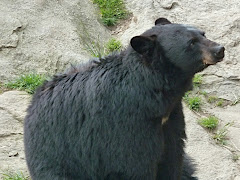coffee
Damian, like 90% of the society, needs his coffee in the morning. Without it he becomes cranky and unfocused. I, on the other hand, am not like the remaining 10% who happily go about their lifes without the daily stimulant. I am in the class of my own: I drink hot milk with a drop or two of coffee for the smell and color. It’s an easy drink to make at home: two minutes in the microwave for the mug full of milk plus whatever coffee Damian has left at the bottom of a French press. Et voilà I am as happy as I can be in the morning - which, truthfully, is not very much. But who needs mornings.
Troubles begin on the road. The first phrase that I learn when traveling abroad is the one for the closest substitute of my milky drink. Latte macchiato works in Italy (not to be confused with caffè macchiato which is a complete opposite and will put me in an overdrive for the rest of the day as Rafał learned first hand), koffie verkeerd in Holland (involves waving hands and making faces on my part and stupefied look by waitstaff due to my lack of language skills), galão in Portugal (perfect proportions for me), café con leche in Spain, café au lait in France (too much coffee if you ask me), and latte in US (or cappuccino, easy on froth when in a fancy restaurant).
Differently than in all those foreign countries, latte - until very recently - was not a staple in US. What passes for coffee in most states is a non descriptive dark brew made in the morning (if you are lucky) and allowed to sit on a heater throughout the day. The cream for it comes in a small plastic container. Or in a sachet of powder creamer which looks and tastes like ground styrofoam. In many cases it even proudly announces its freedom from lactose: no cow has been harmed in preparing this gypsum-like substance it supposedly says. Even Damian refuses to drink coffee in such circumstances.
After years of experiments I’ve learn to ask for a glass of warm milk. Warm, not hot, as the later is greeted with blank look and ends with me explaining the process of obtaining it: pour a cupful of cold milk, put it into microwave for 2 minutes, take it out, bring it to the table. At that point the blank look turns into disbelief and I start to feel I’ll need to teach them how to milk a cow. In a country where all food has to be crisp and all drinks have to be ice cold the idea of warm milk is as foreign as our perplexing accents.
And while warm milk is not an ideal, after adding a spoonful or two of Damian’s coffee I get my drink of choice. Occasionally my order is met with a statement that establishment is out of milk. OK, I’m glad I didn’t order their oatmeal.
When in bed-and-breakfast, my request starts a long conversation with other patrons along the lines: Who’s heard about drinking warm milk in the morning? And with coffee? I suppose it explains why Damian is not too crazy about B&Bs.
Fortunately New Yorkers frequent remote towns in ever increasing numbers and I can get my latte without attracting unduly amount of attention. I prefer local independent coffee shops over Starbucks and not just because I dislike chains: their coffee is too much burned for my taste and so is their milk. I can wholeheartedly recommend Woodstock Coffee & Tea in Woodstock, Vermont having stopped there every Monday morning on my way back to Boston after weekend of skiing. They serve fair traded coffees and have organic milk. When I worked in Cambridge (Chandu, are you reading this?), my coworkers, out of misplaced guilt caused by my overspending on coffee, tried to switch me from Starbucks to Dunkin’ Donuts as they introduced latte. I’ve tried it and it only confirmed my distaste for chains.
Things are changing even in the most remote areas. Case in point: Rangely, Colorado - population 2188, 3 roads, one mediocre restaurant, one terrifying pub - surprised us by having a coffee shop. Google maps, which has a predefined search for coffee, allows us to discover new joints all the time. It’s less than ideal though and from time to time brings up a motel review where an exasperated patron admonishes us to not even think about drinking what passes for coffee in this place. Of course having an espresso machine does not guarantee a potable outcome. Damian slowly becomes a master at judging baristas’ skills, which is tricky since it has to be done while ordering - before one can taste the actual coffee. He claims to be able to figure out if his drink needs a single or a double shot based on the imponderables like the ambiance of the place, behavior of customers, size of the espresso machine, hairstyles and even tattoos of the staff. By comparison I have it easy: I am glad when they don’t burn my milk.
